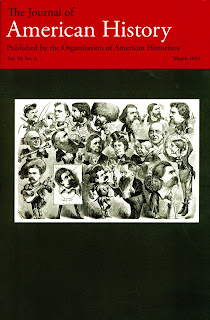BLOOMINGTON, Ind. -- The radical abolitionist George Thompson was a minor celebrity in the mid-19th century. He was imprisoned for five years for a botched attempt to free slaves in Missouri, the author of several books and the head of the African mission established by the Amistad slave rebellion survivors.
"And yet he has been almost completely ignored by historians," writes Joseph Yannielli, who attributes the oversight to a tendency to see militant abolitionists as mentally deranged, along with a failure to engage the global dimensions of the anti-slavery movement. His article "George Thompson among the Africans: Empathy, Authority and Insanity in the Age of Abolition" is included in the March 2010 issue of the Journal of American History, published at Indiana University Bloomington by the Organization of American Historians.
Yannielli argues that dismissing Thompson and other militants as insane is "at best speculative and at worst irresponsible." He shows that Thompson's Christian ideals were tested when he headed the Mendi Mission in Sierra Leone from 1848 to 1856. His 6-year-old son died, his wife and infant son returned to America, and Thompson clashed with local chiefs and used harsh discipline against the native population, once administering 50 lashes to a pregnant woman accused of adultery.

Elizabeth Cady Stanton and Susan B. Anthony are among the popular speakers depicted in "The Lyceum Committeeman's Dream" by C.S. Reinhart (1873), the cover illustration for the most recent Journal of American History.
Photo: "Courtesy of Indiana University." | "But his willingness to transgress conventional social, political and geographic barriers and identify with the oppressed and exploited was a crucial feature of the global battle over slavery, and we lose a great deal by erasing him from our history," Yannielli writes.
Also in the issue:
* Stephen Kantrowitz, in "African American Freemasonry in the Emancipation Era," argues that segregated fraternal organizations, especially the Freemasons, provided an institutional framework in which African American men gained experience in politics, organization and leadership in the years before the Civil War.
* Lisa Tetrault, in "The Incorporation of American Feminism: Suffragists and the Postbellum Lyceum," examines suffragists who earned money by giving lectures in the years after the Civil War. Women such as Susan B. Anthony and Elizabeth Cady Stanton became stars in a system that linked reformist ideals with financial opportunity.
* Joanne Meyerowitz, in "Sexuality, Race, and Mid-Twentieth-Century Social Constructionist Thought," shows how the "culture-and-personality school" of public intellectuals replaced eugenics with a biopolitics of child-rearing and argued that the quality of a population could be enhanced by nurturing certain cultural traits. |
* In the journal's annual "Textbooks and Teaching" section, 10 authors explore the challenges and opportunities of teaching American history in Australia, Lebanon, Russia, Brazil and elsewhere outside of the United States.
In the
JAH Podcast for March 2010, editor Ed Linenthal speaks with contributing editor Scott E. Casper about the "Textbooks and Teaching" feature. The podcast and selected content from the journal are available online at
www.journalofamericanhistory.org/.
FOR IMMEDIATE RELEASE April 5, 2010
















No comments:
Post a Comment